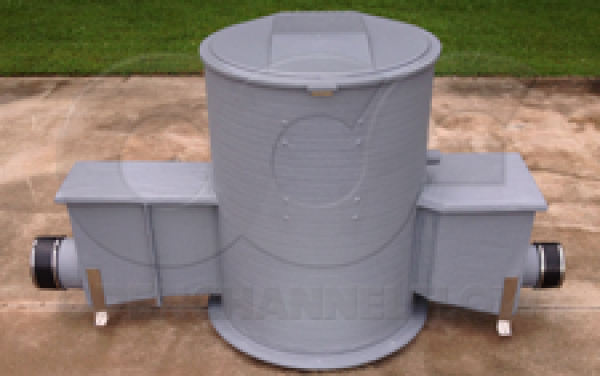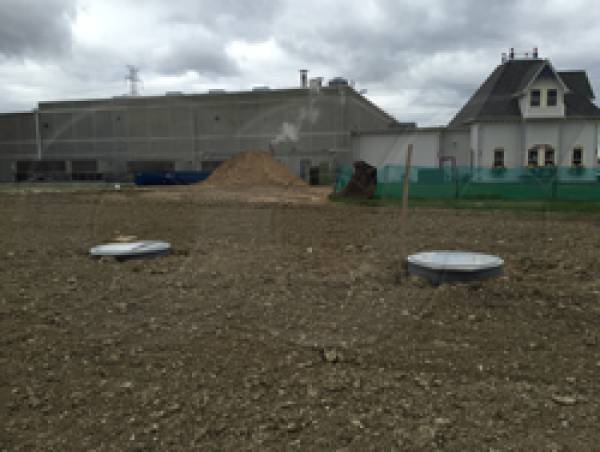This website uses a variety of cookies, which you consent to if you continue to use this site. You can read our Privacy Policy for
details about how these cookies are used, and to grant or withdraw your consent for certain types of cookies.
Industrial Discharge Compliance with Packaged Monitoring Stations
The Federal Water Pollution Control Act of 1948 was the first major U.S. law to address water pollution. Growing public awareness and concern for controlling water pollution led to sweeping amendments in 1972. As amended in 1972, the law became commonly known as the Clean Water Act (CWA).
The 1972 amendments:
- Established the basic structure for regulating pollutant discharges into the waters of the United States.
- Gave EPA the authority to implement pollution control programs such as setting wastewater standards for industry.
- Maintained existing requirements to set water quality standards for all contaminants in surface waters.
- Made it unlawful for any person to discharge any pollutant from a point source into navigable waters, unless a permit was obtained under its provisions.
- Funded the construction of sewage treatment plants under the construction grants program.
- Recognized the need for planning to address the critical problems posed by nonpoint source pollution.†
From an industry standpoint, the primary reason for monitoring a facility is to ensure that the industry is fairly charged for the pollutant load that they discharge to the municipal wastewater treatment system or per a NPDES (National Pollutant Discharge Elimination System) permit to a body of water.
Initially monitoring was a relatively simple process relying on hand-collect grab samples for simple parameters such as sediment, pH, color, and order and then multiplying the result by the incoming water meter. Overtime, municipalities began to realize that proper characterization and quantifications would require more complex methodologies and equipment. Likewise, industries also realized that calculations based on water meter readings could dramatically overstate their discharge load – particularly for industries were the final product contained a significant amount of water (e.g. beverages) or where evaporative losses were high.
As a result, the current equipment set-up used to monitor industrial discharges typically includes:
- Automatic, composite sampler for flow weighted sampling
- Discharge primary device (typically a flume but weirs can sometimes be used) to measure the flow rate
- Flow meter (to measure the flow through the primary device)
- Parameter monitor (single or multiple parameters)
- Data recording (either locally or back to a central system)
Centralized Monitoring Stations
In general it makes more operational sense to locate all of the above equipment at a central packaged monitoring station.
For above ground operations where the discharge piping is accessible, the equipment can be contained indoors in an existing structure or outdoors in a purpose built enclosure. Above ground flows tend to be small (less than 100 gpm [0.6309 l/s]), limiting their use. Additionally, the flow must, oddly enough, be accessible above grade.

Above ground, outdoor enclosures usually house the primary device, sampler strainer / suction line, flow meter sensor, and parameter probes. The composite sampler itself, flow meter display, parameter controller, and data recording equipment are usually housed either inside the plant building or in a separate equipment shelter – commonly a pre-engineered fiberglass one.

Below ground flows – the majority of applications – are conveyed from the industry to the discharge point almost exclusively via piping. The discharge piping may go directly from the plant to a junction with the municipal sewer system or it may be routed through a series of manholes before it joins the municipal sewer.
If an existing manhole is suitable – providing an access point that is both convenient to monitor / sampler from and which meets the necessary upstream / downstream flow conditions for the primary device to function properly – a flume or weir may be installed into the base of the manhole. This can, however, be a difficult task for a number of reasons:
- Condition of the manhole
- Existing manhole channel
- Shape / dimension of the desired flume
- Size of manhole opening (to allow the flume to be passed into the manhole)
Should an existing manhole not be available or not meet the installation criteria, a new monitoring station would be required. These can include:
- A new casting with a concrete manhole / vault
- Use of a fiberglass Packaged Metering Manhole with a factory integrated flume / weir
Conventional concrete castings can be a cost effective option in some cases, but have certain distinct disadvantages:
- Manhole weight (a 4’ dia. X 6’ deep concrete manhole weights on average 6,260 lbs. †† – while a similar fiberglass manhole weights only 515 lbs. or 1/12th the weight)
- Increase manpower and equipment needs (due to unit manhole weight)
- Susceptibility to MICC (Microbial Induced Concrete Corrosion)
- Large (over 4’) diameter manholes (increased cost and installation) to accommodate all but the smallest flumes
- Infiltration (due to lack of watertightness – increasing apparent flow rate through the primary device)
- Improperly formed inlet / outlet transitions (reducing the accuracy of the primary device)
- Extended line downtime (requiring either flow holding or bypass pumping)
Fiberglass Packaged Metering Manholes sidestep these issues, although at a higher initial unit cost. Fabricated according to ASTM D3753, Packaged Metering Manholes integrate a primary device (flume or weir) into a high strength fiberglass manhole. Factory integration allows for the integration of flumes much larger than the manhole barrel’s diameter. Portion of the flume or its end connections that do not fit inside the manhole are reinforced and laminated to the manhole barrel – resulting in the incorporation of flumes much larger than would otherwise be able to be integrated in a similarly sized concrete manhole / vault.
While most flumes can be integrated into Packaged Metering Manholes 4-foot in diameter, larger (5-foot, 6-foot, and 7-foot 8-inch) diameters are available. The larger diameter manholes can allow multiple industrial operators in the manhole at one time or provide additional space to house monitoring equipment (a potential necessity if the manhole is located in a traffic area).
The flexibility of the Packaged Metering Manhole design is such that it can be fabricated with:
- Highway loading (AASHTO/ASTM H-20) reducers for vehicular traffic areas (roads, parking lots, loading docks)
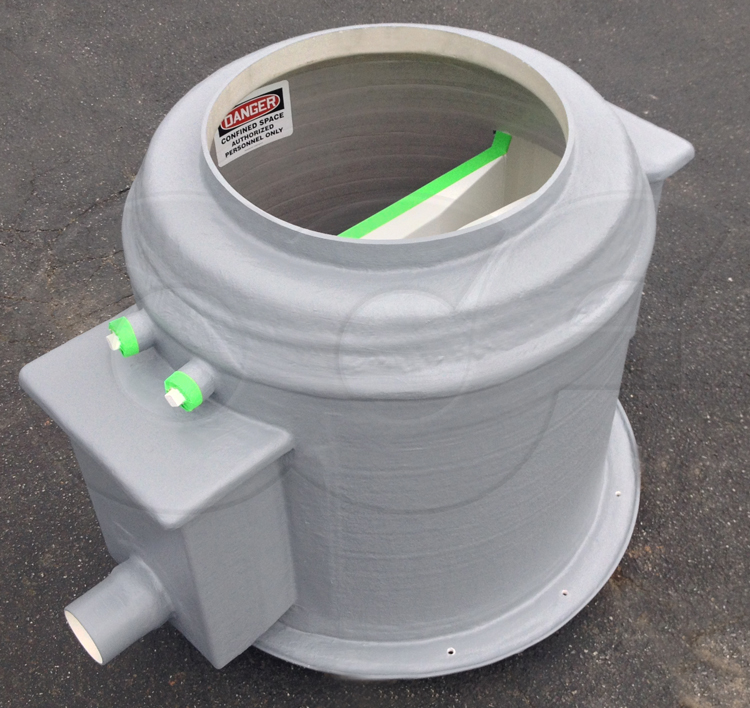
- Aluminum hatches for pedestrian walkways, sidewalks, or where aesthetic concerns dictate a low-profile design
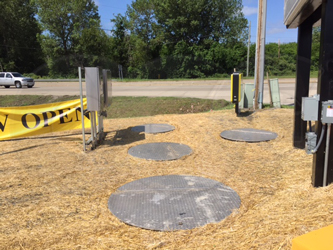
- Dome top for maximum access, non-vehicular / foot traffic applications
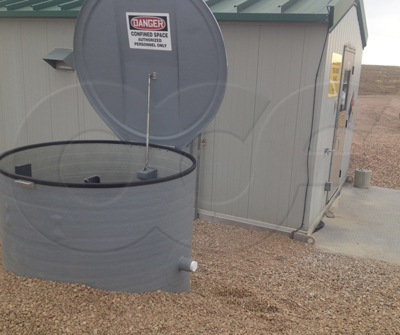
Regardless of which top style is provided, each fiberglass Packaged Metering Manhole has a standard set of benefits:
- Lightweight design
- Weighing 1/10th the weight of a comparable concrete structure – reducing installation equipment / manpower needs
- Drop in place design
- Arriving as a single, integrated piece, Packaged Metering Manholes can be immediately installed at a prepared site – resulting in short line down / pump around times
- Monolithic and watertight
- There are no seams to site-wrap or seal
- Corrosion resistant and able to withstand the effects of MICC
- Low maintenance
- Smooth interior walls are easy to keep clean and there is no need for ongoing maintenance or repair
- Accurate flow measurement
- Engineered inlet / outlet transitions – often extending outside of the manhole barrel - provide improved metering accuracy
In general, properly engineered Packaged Metering Stations provide:
- Accurate flow measurement though the use of a primary device (flume or weir) and flow meter
- Proportional, flow weighted sampling (though the use of a flow meter pacing an automatic sampler and standard suction line / strainer set up or primary device integrated sampler tube at the correct point of measurement)
- Convenient parameter monitoring (integrating parameter sensor(s) at the point of measurement of the primary device)
- Integrated data collection (either through an integrated flow meter with sampler parameter inputs for localized indication or SCADA / remote telemetry systems for centralized, off-site analysis)
Select Resources
- Automatic Samplers
- Data Collection
- Flow Meters
- Parameter Monitors
- Packaged Metering Manholes
- Primary devices
†History of the Clean Water Act
††Ameican Concrete Industries
Related Blog Posts
Explore more insights in our blog.

LOCATIONS IN ATLANTA, GA & BOISE, ID


